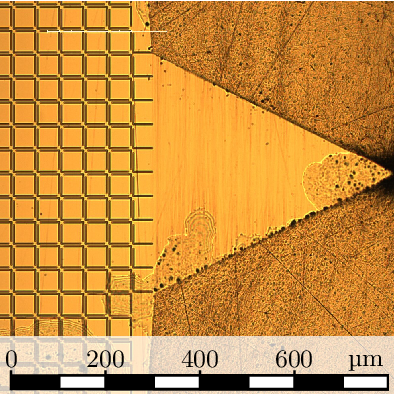Metamaterial devices
“Metamaterials” (MM) are artificial materials whose electrodynamic properties can be tuned by the design of the unit cells they are composed of. It is a very active research area that started with the introduction of negative refractive index by Veselago1 in 1968.
Metamaterials for the design of daily measurement equipment components
Special conditions concerning operating frequency and temperature may limit the availability of measurement component for the daily use. This particularly applies for devices at frequencies between 0.1‑10 THz or for cryogenic temperature applications. In both areas it is partly due to a lack of materials with suitable electromagnetic properties. One way to address this issue is the development of metamaterial components.
Simulation results of a designed band-pass filter2,3: a) shows the schematic sketch of the unit cell. The bottom and the top of the cell are coated with aluminum. The white areas are recesses in the metal layers. The green painted volume consists of silicon. Ф and Θ are the polar and azimuthal angles, respectively, of the depicted reference system. b) and c) Simulation results for the Scattering Parameter (S-Parameter), here the transmission behavior of the band-pass filter. The transmission of an incoming linear polarized wave and its corresponding cross-polarized counterpart is given for various incident angles in Ф and Θ . CO and CR refer to co- and cross-polarized radiation.
We have currently designed metamaterial filters and calibration loads for cryogenic temperature applications at sub-THz frequencies about 200 - 800 GHz. The devices are developed for the calibration measurement setup of an MKID requiring that the setup components have to work at 0.1‑10 K. First measurements of fabricated filter samples have been successfully performed with our new THz time domain spectrometer (Link zu TTDS) and will be presented in the 28th ISSTT international symposium 2017 .
Design:
Mainly used design for our components consists of repetitive L-shaped resonator structures. By means of spatial variations of the resonators we tune the edge steepness of filter bands and are able to prescribe the type of the filter (bandpass, bandstop, etc).
References
[1]: Veselago, Victor (1968). “Electrodynamics of substa simultaneously negative electrical and magnetic properties.” In: Soviet Physics Uspekhi 10.4, pp. 7181-7188
[2]: The simulations have been performed with CST Studio suite (CST - Computer Simulation Technology AG, 2016). We used the frequency domain solver.
[3]: Böhm, Johanna (2016). Master-Thesis: “A metamaterial absorber for the sub-THz regime at cryogenic temperatures”, Universität zu Köln


